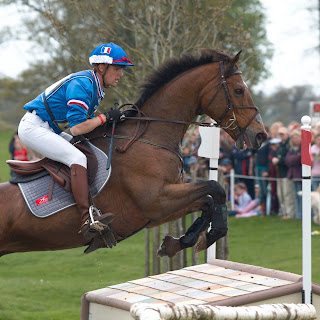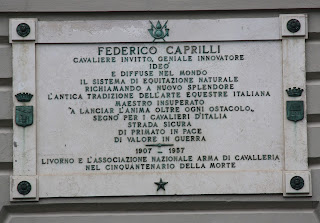First athlete to compete in eight consecutive Games
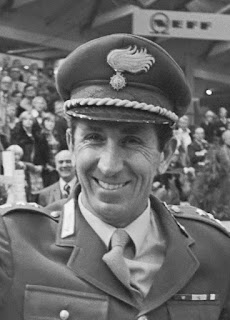 |
| Raimondo D'Inzeo always competed in his Carabinieri uniform |
They achieved the record when they saddled up for the show
jumping events in Montreal in 1976, surpassing the previous record of seven
consecutive summer Games held by the Danish fencer Ivan Osiier, whose run, which
began in 1908 and was interrupted twice by World Wars, had stood since 1948.
The D’Inzeo brothers, whose Olympic journey began in London
in 1948 just as Osiier’s was ending, had chalked off seven Olympics in a row at
Munich in 1972, when each won the last of their six medals in the team event. Raimondo
had carried the Italian flag at the opening ceremony.
Their finest moment came at the 1960 Olympics in their own
country, when they were roared on by a patriotic crowd at the Villa Borghese
Gardens in Rome to complete a one-two in the individual event, Raimondo taking the
gold medal on his horse Posillipo, Piero the silver on The Rock.
Raimondo’s other medal successes had come in Stockholm in
1956, when he won the individual silver and the team silver on Merano. He
collected a team bronze on Posillipo at Tokyo in 1964 and rode Fiorello II to another
team bronze in Munich.
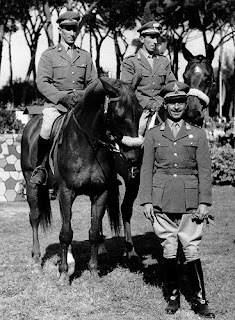 |
| Piero (left) and Raimondo D'Inzeo with a teammate at the Rome Olympics in 1960 |
As it was, their record stood until 1996, when the Austrian
sailor Hubert Raudaschi completed his ninth consecutive Games. The record for
the most appearances at the summer Olympics now stands at 10, which another
showjumper, Canada’s Ian Millar, achieved at London 2012, although his were not
consecutive.
It could be argued that Raimondo D’Inzeo was born to ride.
His father, Carlo, was chief instructor in the Royal Piedmontese Dragoons, an
elite mounted regiment in the Italian army, and later dean of the equestrian
faculty of the Italian sports university La Farnesina in Rome.
Raimondo did not take to riding at first, finding the whole experience
frightening. When he was placed on a horse at the age of 10, he was so scared of being hurt he felt unable to move. But, listening to his
father talking to his brother about horses at home every evening, he began to
feel left out and decided to persevere. Eventually, he felt as comfortable in
the saddle as Piero.
Nonetheless, he decided he wanted a career as an engineer
and persuaded his father to let him enrol at the University of Milan. But he had already grown to love horses and after
a while would spend increasingly less time attending lectures and increasingly more
time at the San Siro horse racing track, even competing in races from time to time.
 |
| Raimondo D'Inzeo with wife Giuliana pictured soon after the medal ceremony at the 1960 Olympics |
D’Inzeo would always compete in uniform, each year with more
pips as he rose eventually to the rank of General. The mounted arm of the Carabinieri were often engaged
in ceremonial roles, although that was not always the case.
In July 1960, shortly before the Olympics, he had to endure
a particularly harrowing episode when he was ordered to lead a charge on
horseback to break up a demonstration in Rome against the government of prime
minister Fernando Tambroni. A
number of people were killed and injured during the violence.
In addition to his Olympic successes, D'Inzeo was the world individual jumping
champion in both 1956 and 1960, and a silver medalist in that event in 1955
and bronze medalist in 1966. He won eight International Grand Prix events
between 1956 and 1975, including the Rome Grand Prix four times. He was a
founding member and former President of the International Jumping Riders Club
(IJRC), which was created in June 1977.
He died in November 2013 at the age of 88, leaving a widow, Giuliana
Mazzetti di Pietralata, a son and a daughter. Another daughter died in a skiing
accident in childhood. Piero passed away
the following February, aged 90.
 |
| The Piazza Martiri della Libertà in Poggio Mirteto as it would have appeared while D'Inzeo was growing up |
D’Inzeo’s birthplace, Poggio Mirteto, a town situated on a hill
overlooking the Tiber river in the province of Rieti in northern Lazio, found
itself on the map in 1849 when the unification army of Giuseppe Garibaldi
stopped in the town with some 4,000 men during a strategic retreat from Rome.
There is a commemorative plaque marking the house where Garibaldi’s wife,
Anita, who was pregnant, spent two nights. The town’s main square was
subsequently renamed Piazza Martiri della Libertà.
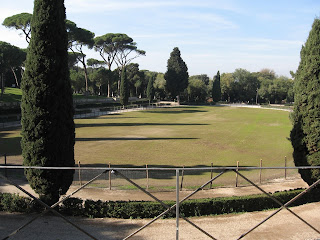 |
| The showjumping competitions at the 1960 Olympics took place at the Piazza di Siena in the Villa Borghese Gardens |
The individual jumping and dressage events at the Rome
Olympics of 1960 took place in an arena constructed at the Piazza di Siena at
the Villa Borghese Gardens, which are among the city’s largest public parks. The
gardens date back to 1605, when Cardinal Scipione Borghese, nephew of Pope Paul
V and patron of the sculptor and architect Gian Lorenzo Bernini, began
converting a former vineyard. Team jumping took place on the final day of the
Games at the Stadio Olimpico, while the eventing contest was staged at the
Centro Equestre Federale, in Pratoni del Vivaro, situated in the town of Rocca
di Papa, not far from the pope’s traditional summer residence at Castel
Gandolfo, 25km (16 miles) southeast of the capital.
More reading:
Emilio Lunghi - Italy's first Olympic medallist
How Dorando Pietro found fame from an Olympic disqualification
Ottavio Missoni - from Olympic hurdler to fashion designer
Also on this day:
1723: The death of anatomist Antonio Maria Valsalva
1891: The birth of former prime minister Antonio Segni
1925: The birth of Olympic showjumper Raimondo D'Inzeo
More reading:
Emilio Lunghi - Italy's first Olympic medallist
How Dorando Pietro found fame from an Olympic disqualification
Ottavio Missoni - from Olympic hurdler to fashion designer
Also on this day:
1723: The death of anatomist Antonio Maria Valsalva
1891: The birth of former prime minister Antonio Segni
1925: The birth of Olympic showjumper Raimondo D'Inzeo


